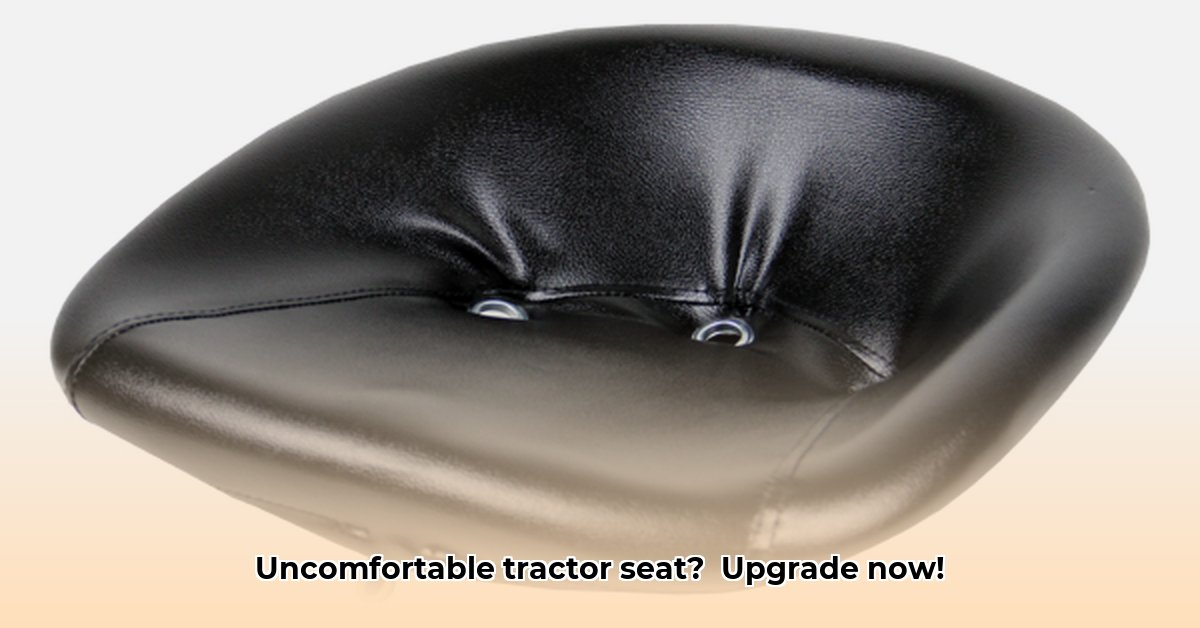
Long days in the field take a toll. Backaches, fatigue, and discomfort aren't just unpleasant; they directly impact your productivity and the long-term health of your farm. Choosing the right tractor seat is an investment in your well-being and the sustainability of your operation. This guide will help you navigate Rural King's tractor seat options and select the perfect fit for your needs and values. For more information on universal tractor seats, check out this helpful resource.
The Comfort Factor: Why Your Seat Matters
Hours spent on a tractor demand a comfortable seat. Discomfort leads to fatigue, reduced efficiency, and increased error rates. But a well-designed seat promotes proper posture, minimizing back pain and exhaustion. This translates to increased productivity—a comfortable farmer is a more productive farmer. Studies show a direct correlation between operator comfort and increased yields. Isn't it time you prioritized your well-being and your farm's bottom line?
Rural King Tractor Seat Options: Finding Your Perfect Fit
Rural King offers a variety of tractor seats catering to diverse budgets and preferences. Let's explore the key categories:
Economy Seats: These budget-friendly options provide basic adjustability, suitable for occasional use or smaller farms.
Suspension Seats: These seats significantly enhance comfort by absorbing vibrations, reducing fatigue from rough terrain. The investment in suspension offers a significant return in reduced operator fatigue.
High-Back Seats: Designed for extended use, these seats offer superior lumbar support and improved ergonomics; they significantly reduce back strain and improve posture.
Here's a quick comparison:
| Rural King Tractor Seat Type | Key Features | Pros | Cons |
|---|---|---|---|
| Economy | Basic adjustability, low price | Budget-friendly, suitable for occasional use | Limited comfort features, may not be suitable for long workdays |
| Suspension | Shock absorption, reduced vibration, enhanced comfort | Increased comfort, reduced fatigue, improved productivity | Higher initial cost |
| High-Back | Superior lumbar support, enhanced posture, comfort | Maximum comfort for long workdays, reduced back strain | Higher price point, potentially larger size |
Sustainability Considerations: A Long-Term Perspective
Sustainable farming extends to the equipment you use. The environmental impact of your tractor seat is a critical factor to consider.
Material Matters: The materials used—steel, leatherette, etc.—impact the environmental footprint. Steel, while durable, has a high carbon footprint. Leatherette, while often cheaper, may not be the most sustainable option. Consider seats made from recycled materials.
Longevity and Durability: A durable seat reduces waste by minimizing the need for replacements. Look for easily replaceable parts to extend its lifespan.
End-of-Life Considerations: Responsible disposal or recycling is essential. Manufacturers committed to sustainability often offer recycling or take-back programs.
Choosing Your Ideal Rural King Tractor Seat: A Step-by-Step Guide
Define Your Budget: Set a realistic budget to narrow your options.
Assess Your Comfort Needs: Consider your typical workday and ergonomic requirements. Do you need extra lumbar support or vibration reduction?
Prioritize Sustainability: Research seats made from recycled materials or those with responsible disposal options.
Check Warranty and Service: A good warranty and readily available parts extend the seat's lifespan.
Looking Ahead: The Future of Sustainable Tractor Seats
The agricultural equipment market is evolving rapidly. Manufacturers are increasingly focused on sustainable materials and designs. The demand for eco-friendly seating is driving innovation towards comfortable and environmentally responsible products. Your choice of a sustainable tractor seat contributes to a more sustainable agricultural future.
Key Takeaways:
- Operator comfort directly impacts productivity and profitability.
- Sustainable tractor seats minimize environmental impact.
- Rural King offers a range of options; careful selection is key.
- Consider seat features, materials, and long-term environmental impact.
- Prioritize both comfort and environmental responsibility.